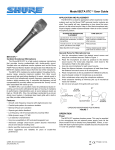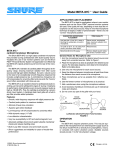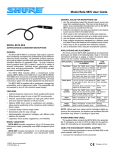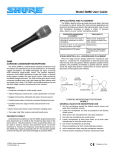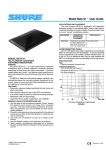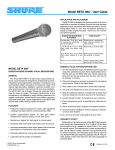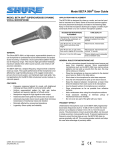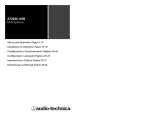Download Shure SM87A Professional Microphone
Transcript
Model SM87A User Guide APPLICATION AND PLACEMENT Some of the most common applications and placement techniques are listed in the following table. Keep in mind that microphone technique is largely a matter of personal taste—there is no one “correct” microphone position. SUGGESTED MICROPHONE PLACEMENT TONE QUALITY Lips less than 15 cm (6 in.) away or touching the windscreen, on axis to microphone. Robust sound, emphasized bass, maximum isolation from other sources. 15 to 60 cm (6 in. to 2 ft.) away from mouth, just above nose height. Natural sound, reduced bass. 20 to 60 cm (8 in. to 2 ft.) away from mouth, slightly off to one side. Natural sound, reduced bass and minimal ”s” sounds. .90 cm to 1.8 m (3 to 6 ft) away. Thinner, distant sound; noticeable levels of ambient noise. General Rules for Microphone Use SM87A SUPERCARDIOID CONDENSER MICROPHONE The Shure Model SM87A is a professional-quality, handheld condenser microphone for use in sound reinforcement, broadcasting, and studio recording installations. Its supercardioid polar pattern provides greater rejection of unwanted sound sources, making it ideal for miking individual instruments in a multi-microphone setting or for miking single sources in a reverberant or noisy environment. The SM87A features a controlled low-frequency roll-off tailored for optimum performance when close-miking sound sources. An integral three-stage wind and pop filter protects against wind and breath noise. Its built-in shock mount reduces stand and handling noise. The SM87A operates on phantom power. Features 1. Aim the microphone toward the desired sound source and at a 125" angle away from unwanted sources. Don’t place unwanted sound sources directly to the rear of the microphone since supercardioid microphones, such as the SM87A, have a narrow pick up range at about 180". Refer to Figure 1. 2. Place the microphone as close as practical to the desired sound source. Refer to the table above. 3. Use only one microphone for each sound source. 4. Keep the distance between microphones at least three times the distance from each source to its microphone. 5. Place microphones as far as possible from reflective surfaces. 6. Work close to the microphone for extra bass response. 7. Use the fewest number of microphones as is practical. 8. Add a windscreen when using the microphone outdoors. 9. Avoid excessive handling to minimize pick up of mechanical noise and vibration. 10. Do not cover any part of the grille with your hand. ! Highly directional supercardioid pickup pattern ! Controlled low-frequency roll-off ! Very low RF and magnetic hum susceptibility ! Minimally affected by varying load impedance 125o ! Built-in wind and pop filter 90o ! Transducer element shock mounted ! Rugged construction for outstanding reliability ! Field-usable over a wide range of temperature and humidity conditions ! Accepts a wide variety of phantom power sources, including DIN 45 596 voltages of 11 and 52 Vdc #2003, Shure Incorporated 27B2964 (Rev. 5) 180o 180o 90o 125o 0o 90o 180o 90o 90o 125o 0o CORRECT 90o CORRECT 0o INCORRECT POSITIONING UNWANTED SOUND SOURCES FIGURE 1 Printed in U.S.A. OPERATION Dynamic Range 116.5 dB (maximum SPL to A-weighted noise level) Signal-to-Noise Ratio 70 dB at 94 dB SPL (IEC 651)* Polarity Positive pressure on diaphragm produces positive voltage on pin 2 relative to pin 3 Power Phantom Supply Requirement . . . . . . . . 11 to 52 Vdc, positive at both pins 2 and 3 Current Drain . . . . . . . . . . . . . . . . . . . . . . . . . . . . . 1.0 to 1.2 mA Connector Three–pin (XLR) professional audio Case Aluminum construction with steel grille and satin black finish Dimensions See Figure 4 Net Weight 200 grams (7 oz) Power The SM87A requires phantom power. This may be supplied to the microphone from an external power supply (such as the Shure model PS1A) or directly from preamplifiers, mixers, or consoles with built-in phantom power. Suitable sources should provide 11 to 52 Vdc phantom voltage. Proximity Effect Unidirectional microphones such as the SM87A progressively boost bass frequencies by 10 to 15 dB at 100 Hz when the microphone is at a distance of about 6 mm (1/4 in.) from the sound source. This phenomenon, known as proximity effect, can be used to create a warmer, more powerful sound. To prevent explosive low frequency sound during close-up use, the SM87A bass response gradually rolls off. This provides greater control and helps the user take advantage of proximity effect. Wind Noise *S/N ratio is difference between 94 dB SPL and equivalent SPL of self– noise A-weighted. The SM87A has an integral wind and pop filter which provides excellent protection against most wind and breath noise. Under adverse conditions, such as high winds or close proximity to a “problem” vocalist, the optional foam windscreen can be used. CERTIFICATION Eligible to bear CE Marking. Conforms to European EMC Directive 89/336/EEC. Meets applicable tests and performance criteria in European Standard EN55103 (1996) parts 1 and 2, for residential (E1) and light industrial (E2) environments. Impedance A minimum load impedance of 800 ohms should be used for maximum signal handling and minimum distortion. The load may be as low as 150 ohms, but a reduction in output signal strength and output clipping level will result. FURNISHED ACCESSORIES Swivel Adapter . . . . . . . . . . . . . . . . . . . . . . . . . . . . . . . . A25D Carrying/Storage Bag . . . . . . . . . . . . . . . . . . . . . . . . . 26A13 OPTIONAL ACCESSORIES SPECIFICATIONS Phantom Power Supply . . . . . . . . . . . . . . . . . . . . . . . . PS1A Isolation Mount . . . . . . . . . . . . . . . . . . . . . . . . A55M, A55HM Windscreen . . . . . . . . . . . . . . . . . . . . . . . . . . . . . . . . . A85WS Cable (7.6 m [25 ft]) . . . . . . . . . . . . . . . . . . . . . . . . . . . . C25F Cartridge Type Condenser (electret bias) Frequency Response 50 to 20,000 Hz (see Figure 2) REPLACEMENT PARTS Polar Pattern Supercardioid (see Figure 3) Screen and Grille . . . . . . . . . . . . . . . . . . . . . . . . . . . RK214G Cartridge and Shock Mount . . . . . . . . . . . . . . . . . . . . . R128 Replacement Amplifier Assembly . . . . . . . . . . . . . . . RK356 Output Impedance Rated at 150 ohms (100 ohms actual $20%) Recommended minimum load impedance: 800 ohms TROUBLESHOOTING Sensitivity (at 1,000 Hz) Open Circuit Voltage . . . . . . . . . . . . . . . –52.5 dBV/Pa (2.4 mV) (1 Pa = 94 dB SPL) If problems arise, test the phantom power source and connectors before calling for service. The microphone will not operate without phantom power. Check the voltage on pins 2 and 3 of the XLR connector going to the microphone. The voltage at pins 2 and 3 with reference to pin 1 should be between 11 and 48 Vdc. For additional service or parts information, please contact Shure’s Service department at 1–800–516–2525. Outside the United States, please contact your authorized Shure Service Center. Clipping Level (at 1,000 Hz) 1000 ohm Load . . . . . . . . . . . . . . . . . . . . . . . . . . –6 dBV (0.5 V) Maximum SPL (at 1,000 Hz) 140.5 dB (0.25% THD, 1000 ohm load) Self-Noise (equivalent sound pressure level; measured with true rms voltmeter) 24 dB typical, A-weighted 26 dB typical, weighted per DIN 45 405 2 MICROPHONE ÉLECTROSTATIQUE À CONFIGURATION SUPERCARDIOÏDE SM87A Règles générales d’utilisation du microphone 1. Diriger le microphone vers la source sonore désirée et à un angle de 125" des sources indésirables. Ne pas placer les sources de bruits indésirables directement derrière le microphone; en effet, les microphones à configuration supercardioïde, comme le SM87A, ont une gamme de captage étroite à environ 180". Se reporter à la figure 1 . 2. Placer le microphone le plus près possible de la source sonore. Se reporter au tableau ci–dessus. Le modèle Shure SM87A est un microphone électrostatique à main de qualité professionnelle pour la sonorisation, la radiodiffusion et les studios d’enregistrement. Sa courbe de directivité à configuration supercardioïde procure un plus grand rejet des sources sonores indésirables, ce qui en fait le micro idéal pour le captage individuel d’instruments dans une configuration à microphones multiples ou pour le captage de sources uniques dans un environnement réverbérant ou bruyant. 3. Utiliser un seul microphone pour chaque source sonore. 4. Maintenir la distance entre les microphones à au moins trois fois la distance de chaque source à son microphone. 5. Placer les microphones aussi loin que possible des surfaces réfléchissantes. Le SM87A est doté d’une atténuation de basse contrôlée étudiée pour des performances optimales lors de la prise de son de près. Un filtre anti–bruit et anti–vent intégré à trois étages protège contre les bruits de vent et de respiration. Sa monture silentbloc intégrée réduit les bruits de manipulation et de supports. Le SM87A fonctionne sur alimentation en duplex. 6. Pour obtenir davantage de basses, placer le microphone le plus près possible de la source sonore. 7. Utiliser le plus petit nombre possible de microphones. 8. Si le microphone est utilisé à l’extérieur, le munir d’un coupe– vent. Avantages ! Configuration supercardioïde hautement directionnelle ! Atténuation de basse contrôlée ! Très faible susceptibilité aux parasites haute fréquence et au ronflement électromagnétique ! Très peu affecté par la variation de l’impédance de charge ! Filtre anti–bruit et anti–vent intégré ! Élément transducteur monté sur un silentbloc ! Construction robuste assurant une fiabilité exceptionnelle ! Utilisable en extérieur sur une plage étendue de températures et d’humidité ! Accepte une grande variété de sources d’alimentation en duplex, notamment les tensions DIN 45 596 de 11 et 52 V c.c. 9. Éviter de manipuler le microphone outre mesure afin de minimiser le captage des bruits mécaniques et des vibrations. 10. Ne couvrir aucune partie du microphone avec la main. 180o 180o 125o Lèvres à moins de 15 cm du coupe–vent ou le touchant, sur l’axe du microphone. Son robuste, graves mises en valeur, isolement maximum des autres sources. De 15 à 60 cm de la bouche, juste au– dessus du nez. Son naturel, graves réduits. De 20 à 60 cm de la bouche, légèrement sur un côté. Son naturel, graves réduits et sifflement minimum des «s». De 90 cm à 1,8 m. Son plus ténu, distant; niveau notable de bruit ambiant. 0o 90o 180o 90o 90o 125o 0o CORRECT 90o CORRECT 0o INCORRECT PLACEMENT DES SOURCES DE BRUITS INDÉSIRABLES FIGURE 1 UTILISATION Alimentation Le SM87A nécessite une alimentation en duplex. Elle peut être fournie au microphone par une alimentation externe (telle que le modèle Shure PS1A) ou directement par les préamplificateurs, mélangeurs ou consoles à alimentation en duplex intégrée. Ces sources doivent fournir une tension en duplex de 11 à 52 V c.c. Certaines des applications et techniques de placement les plus communes sont présentées dans le tableau suivant. Garder à l’esprit que la technique de microphone est surtout une question de préférence personnelle—il n’y a pas de «bonne» position de microphone. QUALITÉ DE LA TONALITÉ 125o 90o APPLICATION ET PLACEMENT PLACEMENT CONSEILLÉ DU MICROPHONE 90o Effet de proximité Les microphones unidirectionnels, tel que le SM87A, amplifient progressivement les fréquences graves de 10 à 15 dB à 100 Hz quand le microphone est à une distance d’environ 6 mm de la source du son. Ce phénomène, appelé effet de proximité, peut être utilisé pour obtenir un son plus chaud, plus puissant. Pour éviter d’avoir des sons graves explosifs pendant l’utilisation rapprochée, le volume des graves du SM87A diminue progressivement. Cela donne un plus grand contrôle et permet à l’utilisateur de profiter de l’effet de proximité. 3 Bruits de vent Le SM87A est doté d’un filtre coupe–vent et «pop» qui offre une excellente protection contre la plupart des bruits de vent et de respiration. Dans des conditions défavorables, telles que par grand vent ou à proximité d’un chanteur «difficile», le coupe–vent optionnel en mousse peut être utilisé. Alimentation Spécification de l’alimentation en duplex 11 à 52 V c.c., positifs aux bornes 2 et 3 Consommation de courant . . . . . . . . . . . . . 1,0 à 1,2 mA Connecteur Audio professionnel à trois broches (XLR) Impédance Une impédance de charge minimale de 800 ohms doit être utilisée pour obtenir un traitement du signal maximal et une distorsion minimale. La charge peut être plus faible, jusqu’à 150 ohms, mais cela résulte en une réduction de l’intensité du signal de sortie et du niveau d’écrêtage de sortie. Boîtier Construction en aluminium avec finition métallique bleue, et grille en acier trempé plaquée chrome et nickel satinée Dimensions Voir figure 4 Poids net 200 grammes CARACTÉRISTIQUES Type de cartouche Condensateur (polarisation d’électret) HOMOLOGATION Autorisé à porter la marque CE. Conforme à la directive CEM européenne 89/336/CEE. Conforme aux critères applicables de test et de performances de la norme européenne EN 55103 (1996) parties 1 et 2 pour les environnements résidentiels (E1) et d’industrie légère (E2). Réponse en fréquence de 50 à 20 000 Hz (voir figure 2) Courbe de directivité Configuration supercardioïde (voir figure 3) Impédance de sortie Nominale à 150 ohms (100 ohms réelle $20 %) Impédance de charge minimale conseillée : 800 ohms ACCESSOIRES FOURNIS Sensibilité (à 1 000 Hz) Tension en circuit ouvert . . . . . . –52.5 dBV/Pa (2.4 mV) (1 Pa = 94 dB NPA) ACCESSOIRES EN OPTION Adaptateur articulé . . . . . . . . . . . . . . . . . . . . . . . . . . . . A25D Sac de transport/remisage . . . . . . . . . . . . . . . . . . . . . 26A13 Alimentation en duplex . . . . . . . . . . . . . . . . . . . . . . . . . PS1A Monture isolante . . . . . . . . . . . . . . . . . . . . . . A55M, A55HM Coupe–vent . . . . . . . . . . . . . . . . . . . . . . . . . . . . . . . . A85WS Câble (7,6 m) . . . . . . . . . . . . . . . . . . . . . . . . . . . . . . . . . C25F Niveau d’écrêtage (à 1 000 Hz) Charge de 1000 ohms . . . . . . . . . . . . . . . . –6 dBV (0,5 V) NPA maximum (à 1 000 Hz) 140.5 dB (0,25 % DHT, charge de 1000 ohms) PIÈCES DE RECHANGE Grille . . . . . . . . . . . . . . . . . . . . . . . . . . . . . . . . . . . . . RK214G Cartouche . . . . . . . . . . . . . . . . . . . . . . . . . . . . . . . . . . . . R128 Amplificateur de rechange . . . . . . . . . . . . . . . . . . . . . RK356 Bruit propre (niveau de pression acoustique équivalent : mesuré avec un voltmètre efficace vrai) 24 dB typique, pondération en A 26 dB typique, pondéré selon DIN 45 405 DÉPANNAGE Si un problème se pose, essayer la source d’alimentation en duplex et les connecteurs avant d’appeler le service après–vente. Le microphone ne fonctionne pas sans alimentation en duplex. Vérifier la tension aux broches 2 et 3 du connecteur type XLR côté microphone. La tension aux broches 2 et 3 par rapport à la broche 1 doit être entre 11 et 48 V c.c. Pour plus de détails sur les réparations ou les pièces, contacter le service Entretien Shure au 1–800–516–2525. À l’extérieur des États–Unis, contacter le centre de réparations Shure agréé. Gamme dynamique 116.5 dB (NPA maximum au niveau de bruit pondéré en A) Rapport signal–bruit 70 dB à une pression acoustique de 94 dB (CEI 651)* Polarité Une pression positive sur le diaphragme produit une tension positive sur la broche 2 par rapport à la broche 3 *Le rapport signal/bruit est la différence entre le niveau de pression acoustique de 94 dB et le NPA équivalent du bruit propre pondéré en A. 4 SM87A SUPERNIEREN–KONDENSATORMIKROFON Allgemeine Regeln für den Mikrofongebrauch 1. Das Mikrofon auf die gewünschte Schallquelle und im Winkel von 125" weg von unerwünschten Schallquellen richten. Unerwünschte Schallquellen nicht unmittelbar hinter dem Mikrofon aufstellen, da Supernieren–Mikrofone, wie das SM87A, einen engen Aufnahmebereich von etwa 180" aufweisen. Siehe Abbildung 1. 2. Das Mikrofon so nahe wie möglich an der gewünschten Schallquelle plazieren. Siehe obige Tabelle. Das Modell Shure SM87A ist ein Kondensator–Handmikrofon in Profiqualität zur Verwendung bei Beschallungs–, Rundfunk– und Tonstudioaufzeichnungsanlagen. Seine Supernieren–Richtcharakteristik bewirkt größere Unterdrükkung unerwünschter Schallquellen, wodurch es ideal für Mikrofonaufnahmen einzelner Instrumente bei einer Anlage mit mehreren Mikrofonen oder für Mikrofonaufnahmen einzelner Schallquellen in einer Umgebung mit Nachhall und Nebengeräuschen ist. 3. Nur ein Mikrofon je Schallquelle verwenden. 4. Den Abstand zwischen Mikrofonen mindestens dreimal so groß wie den Abstand jeder Schallquelle zu ihrem entsprechenden Mikrofon halten. Das SM87A weist einen geregelten Hochpaß–„Rolloff“ auf, der auf optimale Leistung bei Mikrofonnahaufnahmen von Schallquellen abgestimmt ist. Ein integrierter dreistufiger Wind– und Popfilter schützt vor Wind– und Atemgeräuschen. Der eingebaute Schwingmetalldämpfer verringert Stativ– und Handhabungsgeräusche. Das SM87A wird mit Phantomspeisespannung betrieben. 5. Mikrofone so weit wie möglich von Akustikflächen entfernt plazieren. 6. Nahe am Mikrofon arbeiten, um zusätzliches Baßverhalten zu erzielen. 7. Die geringstmögliche Anzahl an Mikrofonen verwenden, die praktikabel ist. Technische Eigenschaften ! Eng gebündelte Supernieren–Richtcharakteristik ! Geregelter Hochpaß–„Rolloff“ ! Sehr niedrige Störempfindlichkeit gegenüber Hochfrequenzen und magnetischem Brumm ! Nur geringfügig durch variable Abschlußimpedanz beeinflußt ! Eingebauter Wind– und Popfilter 8. Bei Einsatz des Mikrofons im Freien einen Windschutz anbringen. 9. Das Mikrofon möglichst ruhig in der Hand halten, um mechanische Störgeräusche und Vibrationen minimal zu halten. 10. Keinen Teil des Grills mit der Hand verdecken. 180o 180o 125o ! Wandlerelement an Schwingmetalldämpfer montiert ! Robuste Ausführung für hervorragende Zuverlässigkeit ! In einem breiten Spektrum von Temperatur– und Feuchtigkeitsbedingungen einsetzbar ! Kann mit einer Vielzahl von Phantomspeisungen betrieben werden, einschließlich DIN 45 596 Spannungswerten von 11 und 52 Volt Gleichspannung Lippen weniger als 15 cm entfernt oder berühren den Windschutz, axial zum Mikrofon. Robuster Klang, betonter Baß, maximale Trennung von anderen Schallquellen. 15 bis 60 cm vom Mund entfernt, unmittelbar über Nasenhöhe. Natürlicher Klang, verringerter Baß. 20 bis 60 cm vom Mund entfernt, etwas zur Seite versetzt. Natürlicher Klang, verringerter Baß und minimale Zischlaute. 90 cm bis 1,8 m entfernt. Dünnerer, entfernter Klang; wahrnehmbare Umgebungsgeräusche. 0o 90o 180o 90o 90o 125o 0o RICHTIG 90o RICHTIG 0o FALSCH PLAZIERUNG UNERWÜNSCHTER SCHALLQUELLEN ABBILDUNG 1 BETRIEB Stromversorgung Das SM87A erfordert Phantomspeisespannung. Das Mikrofon kann durch ein externes Netzteil (wie z.B. das Modell Shure PS1A) oder direkt von Vorverstärkern, Mischern oder Standgeräten mit eingebauter Phantomspeisung versorgt werden. Geeignete Spannungsquellen müssen 11 bis 52 V Phantom–Gleichspannung bieten. Einige der gebräuchlichsten Anwendungen und Plazierungsverfahren sind in der nachstehenden Tabelle aufgeführt. Dabei ist zu berücksichtigen, daß Mikrofontechnik im Grunde „Geschmackssache“ ist — von der „einzig richtigen“ Mikrofonstellung kann nicht die Rede sein. KLANGQUALITÄT 125o 90o VERWENDUNG UND PLAZIERUNG EMPFOHLENE MIKROFONPLAZIERUNG 90o Nahbesprecheffekt Richtmikrofone wie das SM87A verstärken Baßfrequenzen fortschreitend um 10 bis 15 dB bei 100 Hz, wenn sich das Mikrofon in einem Abstand von etwa 6 mm von der Schallquelle befindet. Dieses Phänomen ist als Nahbesprecheffekt bekannt und kann zur Erzeugung eines wärmeren, kräftigeren Klangs verwendet werden. Zur Verhinderung explosiver tieffrequenter Klänge bei Nahaufnahmen weist das SM87A einen Frequenzgang mit stufenweisem Baß–Rolloff auf. Dies bietet größere Klangkontrolle und hilft dem Benutzer, sich den Nahbesprecheffekt zu Nutze zu machen. 5 Windgeräusche Stromversorgung Erforderliche Phantomspeisespannung . 11 bis 52 Volt Gleichspannung, positiv an beiden Pins 2 und 3 Stromentnahme . . . . . . . . . . . . . . . . . . . . . 1,0 bis 1,2 mA Stecker Dreipoliger Profi–Audiostecker (XLR) Gehäuse Aluminiumgehäuse mit blau–metallischer Oberfläche und Grill aus gehärtetem Stahl mit seidenmattglänzender Nikkel–Verchromung Abmessungen Siehe Abbildung 4 Nettogewicht 200 g Das SM87A verfügt über einen integrierten Wind– und Popfilter, der ausgezeichneten Schutz vor den meisten Wind– und Atemgeräuschen bietet. Unter widrigen Bedingungen, wie z.B. bei starkem Wind oder extremer Nähe zu einem „Problemsänger“, kann der als Sonderzubehör erhältliche Schaumstoff–Windschutz verwendet werden. Impedanz Zum Zwecke maximaler Signalverarbeitung und minimaler Verzerrung sollte eine Abschlußimpedanz von mindestens 800 Ohm verwendet werden. Die Abschlußimpedanz kann bis auf 150 Ohm verringert werden; dies führt allerdings zu einer Verringerung der Ausgangssignalstärke und des Ausgangs–Clipping–Pegels. ZERTIFIZIERUNG TECHNISCHE DATEN Zur CE–Kennzeichnung berechtigt. Entspricht der EU–Richtlinie über elektromagnetische Verträglichkeit 89/336/EEC. Erfüllt die Prüfungs– und Leistungskriterien der europäischen Norm EN 55103 (1996) Teil 1 und 2 für Wohngebiete (E1) und Leichtindustriegebiete (E2). Kapseltyp Kondensator (Elektretvorpolung) Frequenzgang 50 bis 20.000 Hz (siehe Abbildung 2) MITGELIEFERTES ZUBEHÖR Richtcharakteristik Superniere (siehe Abbildung 3) Schwenkadapter . . . . . . . . . . . . . . . . . . . . . . . . . . . . . . A25D Tragetasche . . . . . . . . . . . . . . . . . . . . . . . . . . . . . . . . . 26A13 Ausgangsimpedanz Nennwert: 150 Ohm (Ist–Wert: 100 Ohm $20 %) Empfohlene Mindestabschlußimpedanz: 800 Ohm SONDERZUBEHÖR Phantomspeisung . . . . . . . . . . . . . . . . . . . . . . . . . . . . PS1A Isolierhalterung . . . . . . . . . . . . . . . . . . . . . . . . A55M, A55HM Windschutz . . . . . . . . . . . . . . . . . . . . . . . . . . . . . . . . . A85WS Kabel (7,6 m) . . . . . . . . . . . . . . . . . . . . . . . . . . . . . . . . . C25F Empfindlichkeit (bei 1000 Hz) Leerlaufspannung . . . . . . . . . . . –52.5 dBV/Pa (2.4 mV) (1 Pa = 94 dB Schalldruckpegel) ERSATZTEILE Clipping–Pegel (bei 1000 Hz) 1000 Ohm Last . . . . . . . . . . . . . . . . . . . . . . –6 dBV (0,5 V) Grill . . . . . . . . . . . . . . . . . . . . . . . . . . . . . . . . . . . . . . . RK214G Kapsel . . . . . . . . . . . . . . . . . . . . . . . . . . . . . . . . . . . . . . . R128 Ersatzverstärker . . . . . . . . . . . . . . . . . . . . . . . . . . . . . . RK356 Maximaler Schalldruckpegel (bei 1000 Hz) 140.5 dB (0,25 % Gesamtklirrfaktor, 1000 Ohm Last) STÖRUNGSSUCHE Eigenrauschen (äquivalenter Schalldruckpegel; mit wahrem Effektivspannungsmeßgerät gemessen) typisch 24 dB, Bewertungskurve A typisch 26 dB, Bewertungskurve nach DIN 45 405 Bei Auftreten von Störungen bitte die Phantomspeisung und die Stecker prüfen, bevor der Kundendienst angerufen wird. Das Mikrofon funktioniert ohne Phantomspeisespannung nicht. Die Spannungen an den Pins 2 und 3 des zum Mikrofon führenden XLR–Steckers prüfen. Die Spannung an den Stiften 2 und 3 in bezug auf Stift 1 muß zwischen 11 und 48 Volt Gleichspannung betragen. Weitere Informationen über Kundendienst und Ersatzteile erhalten Sie in den USA von der Shure–Kundendienstabteilung unter der Telefonnummer 1–800–516–2525. Außerhalb der Vereinigten Staaten wenden Sie sich bitte an Ihr zuständiges Shure–Kundendienstzentrum unter der Telefonnummer +49 (7131) 7214–0 (Europa/Deutschland) bzw. an die zuständige Landesvertretung. Dynamikbereich 116.5 dB (maximaler Schalldruckpegel zu Geräuschpegel mit Bewertungskurve A) Signalrauschabstand 70 dB bei 94 dB Schalldruckpegel (IEC 651)* Polarität Positiver Druck an der Membran erzeugt positive Spannung an Pin 2 in bezug auf Pin 3. *Signalrauschabstand ist die Differenz zwischen 94 dB Schalldruckpegel und dem äquivalenten Schalldruckpegel des Eigenrauschens mit Bewertungskurve A. 6 SM87A MICROFONO DE CONDENSADOR SUPERCARDIOIDE Reglas generales de uso de micrófonos 1. Apunte el micrófono hacia la fuente sonora deseada y a un ángulo de 125" de las fuentes no deseadas. No coloque las fuentes sonoras no deseadas directamente ”detrás” del micrófono, ya que los micrófonos de supercardioide, tales como el SM87A, tienen un eje estrecho de captación a aproximadamente 180". Consulte la Figura 1. 2. Coloque el micrófono lo más cerca posible a la fuente sonora deseada. Consulte la tabla arriba dada. 3. Utilice sólo un micrófono para captar una fuente sonora. 4. La distancia entre un micrófono y otro deberá ser al menos tres veces la distancia de cada fuente a su micrófono. 5. Aleje los micrófonos lo más posible de las superficies reflectoras. 6. Acérquese al micrófono para obtener mayor respuesta de frecuencias bajas. 7. Utilice el menor número de micrófonos que resulte práctico. 8. Instale una pantalla contra viento si se usa el micrófono a la intemperie. 9. Evite el manejo excesivo para reducir la captación de ruidos mecánicos y vibraciones. 10. No cubra parte alguna de la rejilla con la mano. El modelo SM87A de Shure es un micrófono de condensador de mano de calidad profesional para uso con sistemas de sonido de calidad profesional, difusión y grabaciones en estudio. Su patrón de captación de supercardioide proporciona un mejor rechazo de las fuentes sonoras no deseadas, haciéndolo ideal para la captación de instrumentos individuales en una situación que requiere el uso de varios micrófonos, o para captar una sola fuente en un entorno reverberante o ruidoso. El SM87A cuenta con una atenuación controlada de frecuencias bajas diseñada para ofrecer un rendimiento óptimo cuando se captan fuentes a poca distancia. Su filtro incorporado de tres etapas protege contra los ruidos producidos por el viento y el aliento. Su soporte amortiguado reduce los ruidos de escenario y de manipulación. El SM87A funciona con potencia fantasma. Características ! Patrón de captación de supercardioide altamente direccional ! Atenuación controlada de frecuencias bajas ! Muy baja sensibilidad a la interferencia radioeléctrica (RF) y al zumbido magnético ! 180o 180o Poco perturbado por variaciones en la impedancia de carga ! Filtro contra ruidos causados por el viento y por el aliento ! Transductor montado en soporte amortiguado ! Construcción robusta para excelente confiabilidad ! Se puede usar en campo en una amplia gama de condiciones de temperatura y humedad ! Acepta una gran variedad de fuentes de potencia fantasma, incluyendo fuentes de 11 y 52 VCC configuradas según la norma DIN 45 596 125o 0o CORRECTO De 15 a 60 cm de la boca, justo arriba del nivel de la nariz. Sonido natural, frecuencias bajas reducidas. De 20 a 60 cm de la boca, ligeramente a un lado de ésta. Sonido natural, frecuencias bajas reducidas y pocos sonidos sibilantes. De 90 cm a 1,8 m de distancia. Sonido más agudo y distante; niveles perceptibles de sonido ambiental. 90o 90o 90o CORRECTO 0o INCORRECTO COLOCACION DE FUENTES SONORAS NO DESEADAS FIGURA 1 USO Alimentación El SM87A requiere potencia fantasma. Esta puede ser suministrada al micrófono desde una fuente externa (tal como la fuente Shure PS1A) o directamente desde los preamplificadores, consolas mezcladoras o consolas con capacidad de suministro de potencia fantasma. Las fuentes adecuadas deberán suministrar un voltaje de potencia fantasma de 11 a 52 VCC. CALIDAD DEL TONO Sonido robusto, frecuencias bajas enfatizadas, aislamiento máximo de otras fuentes sonoras. 0o 90o 180o 125o Algunas de las técnicas más comunes de uso y colocación se indican en la tabla siguiente. Recuerde que la técnica de uso de los micrófonos es en gran parte cuestión de gusto personal—no existe una posición de micrófono que sea la “correcta”. Los labios a no más de 15 cm o tocando la pantalla, en línea con el eje de captación del micrófono. 125o 90o USOS Y COLOCACION COLOCACION SUGERIDA DEL MICROFONO 90o Efecto de proximidad Los micrófonos unidireccionales tales como el SM87A introducen un aumento progresivo en las frecuencias bajas de 10 a 15 dB a 100 Hz cuando el micrófono se coloca a aprox. 6 mm de la fuente sonora. Este fenómeno, conocido como el efecto de proximidad, puede usarse para crear un sonido más cálido y fuerte. Para evitar sonidos de baja frecuencia con intensidad explosiva al usar el micrófono de cerca, el SM87A tiene una atenuación progresiva en su respuesta de bajos. Esto ofrece mayor control sobre el sonido y ayuda al usuario a aprovechar el efecto de proximidad. 7 Ruido del viento El SM87A tiene un filtro incorporado que proporciona protección excelente contra la mayor parte de los ruidos del viento y del aliento. Cuando se trabaja en condiciones difíciles, tales como cuando hay vientos fuertes o cuando se capta la voz de un cantante ”problemático”, se puede usar la pantalla opcional de espuma. Alimentación Potencia fantasma requerida . . . . . . . . . . 11 a 52 VCC, positivo en las clavijas 2 y 3 Consumo de corriente . . . . . . . . . . . . . . . . . 1,0 a 1,2 mA Conector Conector de audio de tres clavijas profesional (tipo XLR) Caja Fabricada de aluminio con acabado azul metálico y rejilla de acero endurecido con chapado en cromo niquelado satinado Dimensiones Vea la Figura 4 Peso neto 200 g Impedancia Para aumentar la capacidad de señales y reducir la distorsión es necesario usar una impedancia de carga de por lo menos 800 ohmios. Se puede usar una carga mínima de 150 ohmios, en cuyo caso se experimentará una reducción de la intensidad de la señal de salida y de su nivel de limitación. CERTIFICACIONES ESPECIFICACIONES Califica para llevar las marcas CE. Cumple la directiva europea 89/336/EEC de compatibilidad electromagnética. Se ajusta a los criterios correspondientes de verificación y funcionamiento establecidos en la norma europea EN 55103 (1996), partes 1 y 2, para zonas residenciales (E1) y zonas de industria ligera (E2). Tipo de cápsula Condensador (electreto polarizado) Respuesta de frecuencia 50 a 20.000 Hz (vea la Figura 2) Patrón polar Supercardioide (vea la Figura 3) Impedancia de salida Nominal: 150 ohmios (real: 100 ohmios $ 20%) Impedancia de carga mínima recomendada: 800 ohmios Sensibilidad (a 1000 Hz) Voltaje en circuito abierto . . . . . –52.5 dBV/Pa (2.4 mV) (1 Pa = 94 dB SPL) Nivel de limitación (a 1000 Hz) Carga de 1000 ohmios . . . . . . . . . . . . . . . –6 dBV (0,5 V) SPL máx. (a 1.000 Hz) 140.5 dB (0,25% THD, carga de 1000 ohmios) Ruido inherente (nivel de presión acústica equivalente, medido con medidor RMS real) 24 dB típico, ponderación A 26 dB típico, ponderación según DIN 45 405 Gama dinámica 116.5 dB (SPL máximo a nivel de ruido con ponderación A) Relación de señal a ruido 70 dB a SPL de 94 dB (IEC 651)* Polaridad Una presión positiva sobre el diafragma produce un voltaje positivo en la clavija 2 con respecto a la clavija 3 ACCESORIOS SUMINISTRADOS Adaptador giratorio . . . . . . . . . . . . . . . . . . . . . . . . . . . . A25D Bolsa de transporte . . . . . . . . . . . . . . . . . . . . . . . . . . . 26A13 ACCESORIOS OPCIONALES Fuente de potencia fantasma . . . . . . . . . . . . . . . . . . PS1A Montaje con aislamiento . . . . . . . . . . . . . . . . A55M, A55HM Pantalla . . . . . . . . . . . . . . . . . . . . . . . . . . . . . . . . . . . . A85WS Cable (7,6 m) . . . . . . . . . . . . . . . . . . . . . . . . . . . . . . . . . C25F REPUESTOS Rejilla . . . . . . . . . . . . . . . . . . . . . . . . . . . . . . . . . . . . . RK214G Cápsula . . . . . . . . . . . . . . . . . . . . . . . . . . . . . . . . . . . . . . R128 Amplificador de repuesto . . . . . . . . . . . . . . . . . . . . . . RK356 LOCALIZACION DE AVERIAS Si surgen problemas, pruebe la fuente de potencia fantasma y sus conectores antes de llamar al centro de servicio. El micrófono no funciona sin potencia fantasma. Compruebe el voltaje en las clavijas 2 y 3 del conector XLR que se conecta al micrófono. El voltaje de las clavijas 2 y 3 respecto a la clavija 1 debe medir entre 11 y 48 VCC. Para información adicional acerca del servicio o repuestos, llame al Departamento de servicio Shure al teléfono 1–800–516–2525. Fuera de los EE.UU., llame al servicentro autorizado de productos Shure. * La relación de señal a ruido es la diferencia entre 94 dB SPL y el SPL equivalente del ruido inherente con ponderación A. 8 SM87A MICROFONO A CONDENSATORE A SUPERCARDIOIDE Regole generali per l’uso del microfono 1. Rivolgete il microfono verso la sorgente sonora desiderata e ad un angolo di 125" rispetto alle sorgenti indesiderate. Non collocate sorgenti sonore indesiderate direttamente dietro il microfono, perché i microfoni a supercardioide, come ad esempio il SM87A, hanno uno stretto campo di ricezione, pari a circa 180". Fate riferimento alla Figura 1. Il Modello SM87A Shure è un microfono palmare a condensatore di qualità professionale, adoperabile in impianti di amplificazione sonora, radiodiffusione e in studi di registrazione. Presenta un’elevata reiezione delle sorgenti sonore indesiderate, caratterizzata da un diagramma polare a supercardioide, che lo rende uno strumento ideale per l’uso con singoli strumenti in un sistema a più microfoni o per l’uso di singole sorgenti in un ambiente con riverberazione o rumoroso. 2. Collocate il microfono il più vicino possibile alla sorgente sonora prescelta. Fate riferimento alla tabella precedente. 3. Usate un solo microfono per ogni sorgente sonora. 4. La distanza tra i microfoni deve essere pari a circa tre volte la distanza tra ogni sorgente e il rispettivo microfono. L’SM87A introduce un’attenuazione controllata alle basse frequenze adatta per ottenere prestazioni ottimali in caso di utilizzazione di sorgenti sonore a distanza ravvicinata. Un filtro antivento e antischiocco integrale a tre stadi protegge dai rumori del vento e della respirazione. Il supporto antivibrazione incorporato riduce i rumori del sostegno e degli spostamenti del microfono. L’SM87A funziona con alimentazione virtuale. 5. Collocate i microfoni il più lontano possibile dalle superfici riflettenti. 6. Per una risposta più elevata ai bassi, tenete il microfono molto vicino alle labbra. 7. Usate il minor numero di microfoni possibile. 8. Se usate il microfono all’esterno, adoperate un antivento. Caratteristiche ! Diagramma di ricezione a supercardioide con alta direttività ! Attenuazione controllata alle basse frequenze ! Suscettività molto bassa alla radiofrequenza e al ronzio magnetico ! Minima influenza delle variazioni dell’impedenza di carico ! Filtro antivento e antischiocco incorporato ! Elemento trasduttore con supporto antivibrazione ! Esecuzione robusta, che garantisce un’affidabilità eccezionale ! Utilizzabile in un ampio campo di temperature e umidità ! Accetta una vasta gamma di alimentazioni virtuali, comprese le tensioni DIN 45 596 da 11 e 52 V c.c. 9. Evitate movimenti eccessivi del microfono, per ridurre al minimo la ricezione di rumori e vibrazioni meccaniche. 10. Non coprite la griglia con le mani. 180o 180o 125o 0o GIUSTA Distanza della bocca da 15 a 60 cm, appena sopra il naso. Suono naturale, toni bassi ridotti. Distanza della bocca da 20 a 60 cm leggermente spostato da un lato. Suono naturale, toni bassi ridotti e attenuazione dei suoni sibilanti. Distanza da a 90 cm a 1,8 m. Suono distante e affievolito; livelli significativi di rumore ambientale. 90o 90o 90o GIUSTA 0o ERRATA COLLOCAZIONE DI SORGENTI SONORE INDESIDERATE FIGURA 1 USO Alimentazione Il modello SM87A necessita di alimentazione virtuale, che può essere applicata al microfono da un alimentatore esterno (ad esempio il modello PS1A Shure) o direttamente da preamplificatori, mixer o consolle con alimentazione virtuale incorporata. Le sorgenti adeguate devono applicare un’alimentazione virtuale compresa tra 11 e 52 V c.c. QUALITÀ DEI TONI Suono robusto, enfasi dei toni bassi, massimo isolamento dalle altre sorgenti. 0o 90o 180o 125o La tabella seguente indica le applicazioni e le tecniche di collocazione più comuni. Tenete presente che la collocazione dei microfoni è principalmente una questione di gusto personale—non esiste una posizione “corretta” in cui disporre il microfono. Labbra a meno di 15 cm o in contatto con l’antivento, in asse con il microfono. 125o 90o APPLICAZIONE E COLLOCAZIONE POSIZIONE CONSIGLIATA PER IL MICROFONO 90o Effetto di prossimità I microfoni unidirezionali, quali ad esempio il SM87A, amplificano progressivamente le basse frequenze da 10 a 15 dB a 100 Hz quando il microfono si trova ad una distanza di circa 6 mm dalla sorgente sonora. Questo fenomeno, chiamato effetto di prossimità, può essere utilizzato per creare un suono più caldo e potente. Per evitare un suono esplosivo alle basse frequenze durante l’uso a distanza ravvicinata, la risposta ai bassi del SM87A si attenua gradualmente. Ciò fornisce un maggiore controllo e permette all’utente di sfruttare l’effetto di prossimità. 9 Rumore del vento Polarità Una pressione positiva sul diaframma produce una tensione positiva sul piedino 2 rispetto al piedino 3 Il SM87A è dotato di un filtro fonoassorbente e antischiocco integrale che garantisce un’ottima protezione contro i rumori causati dal vento e dalla respirazione. In condizioni sfavorevoli, ad esempio un forte vento o in vicinanza di un cantante “problematico”, è possibile adoperare l’antivento in schiuma poliuretanica opzionale. Alimentazione Requisiti di alimentazione virtuale da 11 a 52 V c.c., positiva su entrambi i piedini 2 e 3 Corrente assorbita da 1,0 a 1,2 mA Connettore Audio professionale a tre piedini (XLR) Custodia In alluminio con finitura metallica blu e griglia in acciaio temprato con rivestimento satinato in nichel–cromo Impedenza Per ottenere un’attenuazione e una distorsione minime del segnale, usate un’impedenza di carico di almeno 800 ohm. Il carico può essere anche solo di 150 ohm, ma ciò produrrà una riduzione dell’intensità e del livello di limitazione del segnale di uscita. Dimensioni Vedi Figura 4 Peso netto 200 grammi DATI TECNICI Tipo di capsula A condensatore (polarizzazione a elettrete) CERTIFICAZIONI Contrassegnabile con il marchio CE. Conforme alla direttiva europea sulla compatibilità elettromagnetica 89/336/CEE. Conforme ai criteri sulle prestazioni e alle prove pertinenti specificati nella norma europea EN 55103 (1996) parti 1 e 2, per ambienti residenziali (E1) e industriali leggeri (E2). Risposta in frequenza Da 50 a 20.000 Hz (vedi Figura 2) Diagramma polare A supercardioide (vedi Figura 3) Impedenza di uscita Valore nominale 150 ohm (valore effettivo 100 ohm $20%) Impedenza di carico minima consigliata: 800 ohm ACCESSORI IN DOTAZIONE Adattatore a snodo . . . . . . . . . . . . . . . . . . . . . . . . . . . . A25D Custodia per trasporto/conservazione . . . . . . . . . . . 26A13 Sensibilità (a 1.000 Hz) Tensione a circuito aperto . . . . . –52.5 dBV/Pa (2.4 mV) (1 Pa = 94 dB SPL) ACCESSORI IN OPZIONE Alimentazione virtuale . . . . . . . . . . . . . . . . . . . . . . . . PS1A Supporto con isolamento . . . . . . . . . . . . . . . A55M, A55HM Antivento . . . . . . . . . . . . . . . . . . . . . . . . . . . . . . . . . . A85WS Cavo (7.6 m) . . . . . . . . . . . . . . . . . . . . . . . . . . . . . . . . . . C25F Livello di limitazione (a 1.000 Hz) Carico di 1000 ohm . . . . . . . . . . . . . . . . . . –6 dBV (0.5 V) Livello di pressione sonora (SPL) max. (a 1.000 Hz) 140.5 dB (0,25% distorsione armonica totale [THD], carico di 1000 ohm) COMPONENTI DI RICAMBIO Griglia . . . . . . . . . . . . . . . . . . . . . . . . . . . . . . . . . . . . RK214G Capsula . . . . . . . . . . . . . . . . . . . . . . . . . . . . . . . . . . . . . . R128 Gruppo amplificatore di ricambio . . . . . . . . . . . . . . . . RK356 Rumore generato internamente (livello di pressione sonora equivalente; misurato con un voltmetro a vero valore efficace) 24 dB (valore tipico), filtro di ponderazione A 26 dB (valore tipico), filtro di ponderazione a norma DIN 45 405 SOLUZIONE DEI PROBLEMI Se si presentano problemi, prima di richiedere assistenza tecnica verificate la sorgente di alimentazione virtuale e i connettori. Il microfono non funziona senza alimentazione virtuale. Verificate la tensione ai piedini 2 e 3, rispetto al piedino 1, del connettore XLR all’ingresso del microfono; deve essere compresa tra 11 e 48 V c.c. Per assistenza tecnica o informazioni sui ricambi, rivolgetevi alla Shure chiamando il numero 1–800–516–2525. Fuori degli USA, rivolgetevi a un centro di assistenza Shure autorizzato. Gamma dinamica 116.5 dB (SPL max. al livello di rumore con filtro di ponderazione A) Rapporto segnale/rumore 70 dB a 94 dB SPL (IEC 651)* *Il rapporto segnale/rumore corrisponde alla differenza tra 94 dB di livello di pressione sonora (SPL) e l’equivalente SPL di rumore generato internamente e misurato con filtro di ponderazione A. 10 150o 180o 150o 120o 10 mm (3/8 in.) 150o 120o 180o 150o 120o 120o dB +10 90o 0 90o 90o 90o –20 dB –20 dB –15 dB 60o –10 –15 dB 60o –10 dB 60o 30o 20 50 100 2 3 4 5 6 7 89 1000 2 0 3 4 5 6 7 89 10000 20000 –5 dB 30o 100 Hz 500 Hz, 1000 Hz Hz 60o –10 dB –5 dB 30o 30o 0 3150 Hz 10000 Hz TYPICAL POLAR PATTERN COURBE DE DIRECTIVITÉ TYPIQUE TYPISCHE RICHTCHARAKTERISTIK PATRON POLAR TIPICO DIAGRAMMA POLARE TIPICO TYPICAL FREQUENCY RESPONSE RÉPONSE EN FRÉQUENCE TYPIQUE TYPISCHER FREQUENZGANG RESPUESTA DE FRECUENCIA TIPICA RISPOSTA IN FREQUENZA TIPICA FIGURE 3 ! ABBILDUNG 3 ! FIGURA 3 FIGURE 2 ! ABBILDUNG 2 ! FIGURA 2 192 mm (7–9/16 in.) 21.0 mm (53/64 in.) 50.8 mm (2 in.) OVERALL DIMENSIONS DIMENSIONS HORS TOUT GESAMTABMESSUNGEN DIMENSIONES GENERALES DIMENSIONI COMPLESSIVE FIGURE 4 ! ABBILDUNG 4 ! FIGURA 4 11 SHURE Incorporated Web Address: http://www.shure.com 5800 W. Touhy Avenue, Niles, IL 60714-4608, U.S.A. Phone: 800-257-4873 Fax: 847-600-1212 In Europe, Phone: 49-7131-72140 Fax: 49-7131-721414 In Asia, Phone: 852-2893-4290 Fax: 852-2893-4055 Elsewhere, Phone: 847-600-2000 Fax: 847-600-6336












